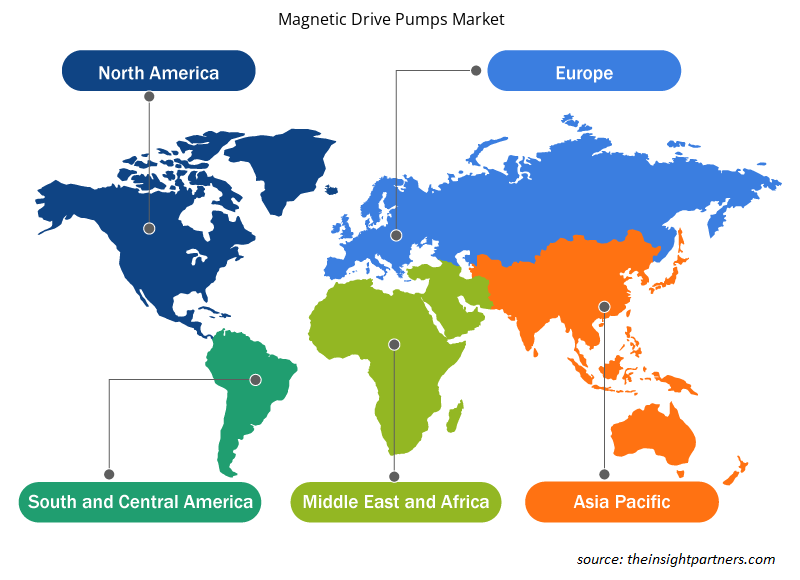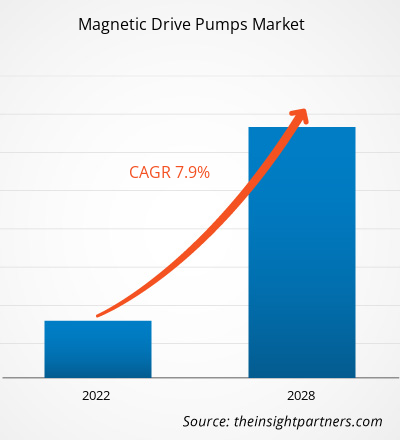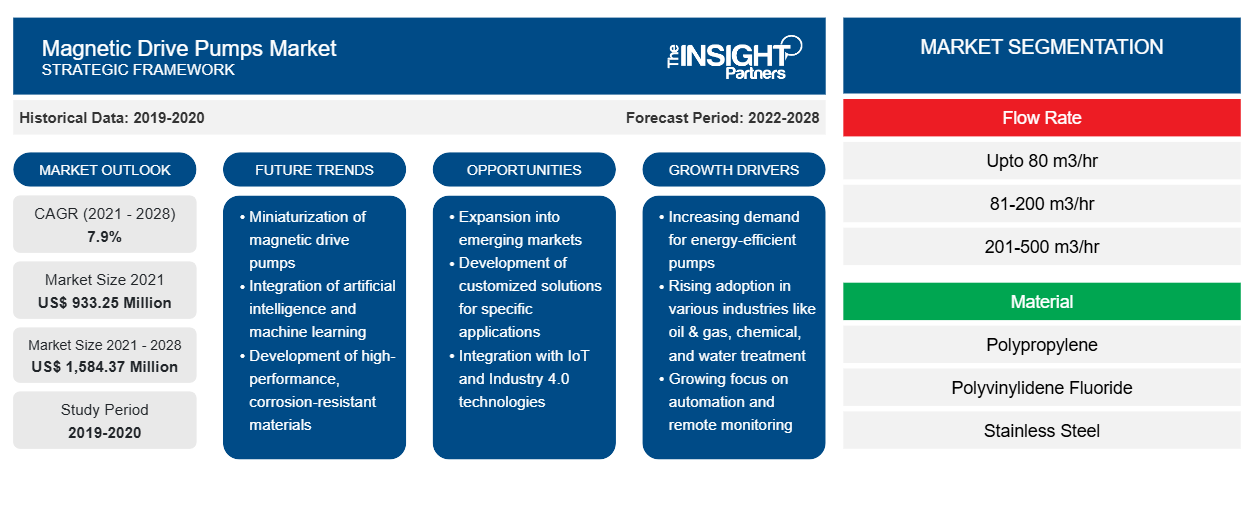[Rapporto di ricerca] Si prevede che il mercato delle pompe a trasmissione magnetica crescerà da 933,25 milioni di dollari nel 2021 a 1.584,37 milioni di dollari entro il 2028; si stima che crescerà a un CAGR del 7,9% nel periodo 2021-2028.CAGR of 7.9% during 2021–2028.
Prospettiva dell'analista:
Il mercato delle pompe a trasmissione magnetica è un settore in rapida crescita nell'industria globale delle pompe . Le pompe a trasmissione magnetica, note anche come pompe a trasmissione magnetica o pompe ad accoppiamento magnetico, sono progettate per eliminare la necessità delle tradizionali tenute meccaniche utilizzando un accoppiamento magnetico per trasferire la coppia dal motore alla girante. Questa tecnologia offre diversi vantaggi, tra cui funzionamento senza perdite, requisiti di manutenzione ridotti e maggiore sicurezza. Il mercato delle pompe a trasmissione magnetica ha assistito a una crescita significativa negli ultimi anni, guidata da vari fattori. Uno dei principali fattori trainanti è la crescente domanda di soluzioni di pompaggio senza guarnizioni in settori quali l'elaborazione chimica, i prodotti farmaceutici, il trattamento delle acque e il petrolio e il gas. La capacità delle pompe a trasmissione magnetica di eliminare le perdite e ridurre il rischio di esposizione a materiali pericolosi le rende altamente desiderabili in queste applicazioni. Inoltre, le severe normative ambientali e una crescente enfasi sull'efficienza operativa hanno alimentato l'adozione di pompe a trasmissione magnetica. L'eliminazione delle perdite non solo riduce la perdita di prodotto, ma riduce anche al minimo l'impatto sull'ambiente. Inoltre, le pompe a trasmissione magnetica offrono una migliore efficienza energetica rispetto alle pompe tradizionali, contribuendo al risparmio sui costi e alla sostenibilità.
Il mercato delle pompe a trascinamento magnetico è caratterizzato da vari tipi di pompe a trascinamento magnetico, tra cui pompe centrifughe, a turbina e a ingranaggi, ciascuna adatta per applicazioni e requisiti specifici. Le pompe centrifughe a trascinamento magnetico sono il tipo più comunemente utilizzato, offrendo portate elevate e capacità di pressione moderate. Le pompe a trascinamento magnetico a turbina sono adatte per applicazioni a bassa portata e alta pressione, mentre le pompe a trascinamento magnetico a ingranaggi sono ideali per la gestione di fluidi viscosi.
Panoramica del mercato:
Le pompe a trasmissione magnetica spostano il fluido attraverso una pompa impiegando un magnete di trasmissione e un magnete interno collegato a una girante. Il magnete di trasmissione e il magnete interno sono separati da un involucro posteriore e da un alloggiamento, con conseguente confinamento senza tenuta. L'utilizzo di una pompa a trasmissione magnetica può prevenire perdite di fluido e, cosa ancora più importante, la perdita di sostanze potenzialmente pericolose e costose. Le pompe senza guarnizioni non hanno emissioni fuggitive, il che consente loro di rispettare tutte le normative. Con una maggiore consapevolezza ambientale e normative EPA più severe, le pompe senza guarnizioni possono rispettare tutti i requisiti perché non producono emissioni fuggitive.
Personalizza questo report in base alle tue esigenze
Riceverai la personalizzazione gratuita di qualsiasi report, comprese parti di questo report, o analisi a livello nazionale, pacchetto dati Excel, oltre a usufruire di grandi offerte e sconti per start-up e università
-
Scopri le principali tendenze di mercato in questo rapporto.Questo campione GRATUITO includerà analisi di dati che spaziano dalle tendenze di mercato alle stime e alle previsioni.
Fattore trainante del mercato:
Aumento dell'uso del trattamento delle acque per progetti di trattamento delle acque per guidare la crescita del mercato delle pompe a trasmissione magnetica
L'aumento dell'uso del trattamento delle acque per i progetti di trattamento delle acque è un fattore determinante per il mercato delle pompe a trasmissione magnetica. Il trattamento delle acque svolge un ruolo cruciale nella purificazione e nella garanzia della disponibilità di acqua pulita per varie applicazioni, tra cui acqua potabile, processi industriali e irrigazione agricola. Con l'aumento della domanda di acqua pulita, la necessità di soluzioni efficaci ed efficienti per il trattamento delle acque diventa sempre più critica. Le pompe a trasmissione magnetica trovano ampia applicazione nei processi di trattamento delle acque grazie al loro design senza guarnizioni e alla capacità di gestire fluidi corrosivi e pericolosi. Queste pompe sono adatte per la gestione di sostanze chimiche, acidi e altre sostanze aggressive comunemente utilizzate nelle operazioni di trattamento delle acque. L'assenza di guarnizioni meccaniche elimina il rischio di perdite e contaminazione, garantendo l'integrità dell'acqua trattata. I progetti di trattamento delle acque comprendono varie applicazioni, tra cui impianti di trattamento delle acque comunali, impianti di trattamento delle acque reflue industriali, impianti di desalinizzazione e progetti di bonifica delle falde acquifere. In queste applicazioni, le pompe a trasmissione magnetica sono fondamentali per il pompaggio e la circolazione dell'acqua attraverso varie fasi di trattamento, come filtrazione, disinfezione, dosaggio chimico e gestione dei fanghi.
La crescente enfasi sulle normative ambientali e sugli standard di qualità dell'acqua spinge ulteriormente l'adozione di pompe a trasmissione magnetica nei progetti di trattamento delle acque. Le severe normative richiedono sistemi di pompaggio affidabili e senza perdite per impedire il rilascio di inquinanti nei corpi idrici. Le pompe a trasmissione magnetica forniscono una soluzione affidabile eliminando il potenziale di perdite e garantendo la protezione dell'ambiente. Inoltre, l'efficienza e i vantaggi operativi delle pompe a trasmissione magnetica le rendono una scelta interessante per i progetti di trattamento delle acque. Queste pompe presentano un'elevata efficienza energetica, che aiuta a ridurre i costi operativi e a minimizzare l'impatto ambientale. Inoltre, l'assenza di tenute meccaniche si traduce in minori requisiti di manutenzione, risparmiando tempo e risorse per gli operatori del trattamento delle acque.
Analisi segmentale: Analysis:
In base al materiale, il mercato è suddiviso in polipropilene, fluoruro di polivinilidene, acciaio inossidabile, leghe di nichel, PFA ed ETFE. Il segmento dell'acciaio inossidabile ha detenuto la quota maggiore del mercato delle pompe a trasmissione magnetica nel 2020, mentre si prevede che il segmento delle leghe di nichel registrerà il CAGR più elevato nel mercato durante il periodo di previsione. Il segmento dell'elaborazione chimica detiene la quota maggiore del mercato delle pompe a trasmissione magnetica. Le pompe a trasmissione magnetica sono ampiamente utilizzate nell'elaborazione chimica perché gestiscono fluidi corrosivi e prevengono le perdite. L'attenzione del settore alla sicurezza, alle normative ambientali e all'efficienza operativa spinge l'adozione di pompe a trasmissione magnetica. Queste pompe offrono un funzionamento senza perdite, garantendo l'integrità dei materiali pericolosi e riducendo la perdita di prodotto. Forniscono inoltre efficienza energetica, minori requisiti di manutenzione e supportano l'ottimizzazione dei processi. Con l'espansione dell'industria chimica, le pompe a trasmissione magnetica rimarranno fondamentali per soddisfare le sue esigenze di pompaggio.
Analisi regionale:
Il mercato delle pompe a trasmissione magnetica dell'Asia Pacifico è stato valutato a 0,31 miliardi di $ USA nel 2021 e si prevede che raggiungerà 0,58 miliardi di $ USA entro il 2028; si prevede che crescerà a un CAGR del 9,3% durante il periodo di previsione. La regione dell'Asia Pacifico è emersa come il mercato dominante delle pompe a trasmissione magnetica, esibendo una crescita sostanziale e una quota di settore significativa. Il predominio della regione può essere attribuito a diversi fattori chiave che hanno contribuito alla sua leadership di mercato. La regione dell'Asia Pacifico ha sperimentato una rapida industrializzazione e crescita economica negli ultimi decenni. Ciò ha aumentato la domanda di vari processi industriali, tra cui la produzione chimica, la produzione farmaceutica, il trattamento delle acque e altro ancora. La necessità di soluzioni di pompaggio affidabili ed efficienti in questi settori ha portato a un'adozione significativa delle pompe a trasmissione magnetica. La grande popolazione della regione e la crescente urbanizzazione hanno spinto la domanda di infrastrutture migliorate, tra cui impianti di trattamento delle acque e delle acque reflue . Le pompe a trasmissione magnetica svolgono un ruolo fondamentale in questi progetti, garantendo una gestione efficiente e sicura dei fluidi in diverse applicazioni. L'attenzione della regione allo sviluppo sostenibile e al rispetto delle normative ambientali ha ulteriormente stimolato l'adozione di pompe a trascinamento magnetico nei processi di trattamento delle acque.
La regione Asia-Pacifico ha numerosi hub di produzione, in particolare in paesi come Cina, India e Corea del Sud. Questi paesi hanno una solida presenza in settori quali prodotti chimici, petrolchimici ed elettronici, che sono i principali consumatori di pompe a trasmissione magnetica. Le capacità di produzione locale e i vantaggi in termini di costi di questi paesi hanno alimentato la crescita del mercato. I progressi nella tecnologia e i crescenti investimenti in ricerca e sviluppo hanno svolto un ruolo cruciale nel dominio del mercato della regione. I produttori nella regione Asia-Pacifico sono stati in prima linea nello sviluppo di soluzioni innovative per pompe a trasmissione magnetica che soddisfano specifiche esigenze del settore. Ciò ha ulteriormente rafforzato la loro competitività e ha contribuito alla forte posizione di mercato della regione.
Analisi dei giocatori chiave:
L'analisi di mercato delle pompe a trascinamento magnetico è composta da attori quali IWAKI CO., LTD.; Sundyne; Klaus Union GmbH & Co. KG; Flowserve Corporation; Dickow Pump Company; KSB SE & Co. KGaA; ITT Goulds Pumps; Sulzer Ltd; Finish Thompson, Inc.; OPTIMEX; HERMETIC-Pumpen GmbH; CP Pumpen AG; e CDR Pumps. Tra gli attori delle pompe a trascinamento magnetico Sulzer Ltd e Klaus Union GmbH & Co. KG sono tra i principali attori grazie al portafoglio di prodotti diversificato offerto.
Approfondimenti regionali sul mercato delle pompe a trasmissione magnetica
Le tendenze regionali e i fattori che influenzano il mercato delle pompe a trasmissione magnetica durante il periodo di previsione sono stati ampiamente spiegati dagli analisti di Insight Partners. Questa sezione discute anche i segmenti e la geografia del mercato delle pompe a trasmissione magnetica in Nord America, Europa, Asia Pacifico, Medio Oriente e Africa e Sud e Centro America.

- Ottieni i dati specifici regionali per il mercato delle pompe a trasmissione magnetica
Ambito del rapporto di mercato sulle pompe a trasmissione magnetica
| Attributo del report | Dettagli |
|---|---|
| Dimensioni del mercato nel 2021 | 933,25 milioni di dollari USA |
| Dimensioni del mercato entro il 2028 | 1.584,37 milioni di dollari USA |
| CAGR globale (2021 - 2028) | 7,9% |
| Dati storici | 2019-2020 |
| Periodo di previsione | 2022-2028 |
| Segmenti coperti |
Per portata
|
| Regioni e Paesi coperti |
America del Nord
|
| Leader di mercato e profili aziendali chiave |
|
Densità dei player del mercato delle pompe a trasmissione magnetica: comprendere il suo impatto sulle dinamiche aziendali
Il mercato delle pompe a trasmissione magnetica sta crescendo rapidamente, spinto dalla crescente domanda degli utenti finali dovuta a fattori quali l'evoluzione delle preferenze dei consumatori, i progressi tecnologici e una maggiore consapevolezza dei vantaggi del prodotto. Con l'aumento della domanda, le aziende stanno ampliando le loro offerte, innovando per soddisfare le esigenze dei consumatori e capitalizzando sulle tendenze emergenti, il che alimenta ulteriormente la crescita del mercato.
La densità degli operatori di mercato si riferisce alla distribuzione di aziende o società che operano in un particolare mercato o settore. Indica quanti concorrenti (operatori di mercato) sono presenti in un dato spazio di mercato in relazione alle sue dimensioni o al valore di mercato totale.
Le principali aziende che operano nel mercato delle pompe a trasmissione magnetica sono:
- Società per azioni Flowserve
- Sulzer Ltd
- KSB SE & Co. KGaA
- Soleggiato
- Unione di Klaus
Disclaimer : le aziende elencate sopra non sono classificate secondo un ordine particolare.

- Ottieni una panoramica dei principali attori del mercato delle pompe a trasmissione magnetica
Sviluppi recenti:
Le strategie inorganiche e organiche come fusioni e acquisizioni sono ampiamente adottate dalle aziende nel mercato delle pompe a trasmissione magnetica. Di seguito sono elencati alcuni recenti sviluppi chiave del mercato:
- Nel gennaio 2021, Flowserve Corporation, fornitore leader a livello mondiale di prodotti e servizi per il controllo dei flussi, ha lanciato una suite di servizi IoT per consentire il monitoraggio remoto degli impianti di produzione, comprese pompe di ogni tipo, prevedere guasti alle apparecchiature ed evitare interruzioni aziendali.
- Analisi storica (2 anni), anno base, previsione (7 anni) con CAGR
- Analisi PEST e SWOT
- Valore/volume delle dimensioni del mercato - Globale, Regionale, Nazionale
- Industria e panorama competitivo
- Set di dati Excel
Report recenti
Rapporti correlati
Testimonianze
Motivo dell'acquisto
- Processo decisionale informato
- Comprensione delle dinamiche di mercato
- Analisi competitiva
- Analisi dei clienti
- Previsioni di mercato
- Mitigazione del rischio
- Pianificazione strategica
- Giustificazione degli investimenti
- Identificazione dei mercati emergenti
- Miglioramento delle strategie di marketing
- Aumento dell'efficienza operativa
- Allineamento alle tendenze normative























 Ottieni un campione gratuito per - Mercato delle pompe a trascinamento magnetico
Ottieni un campione gratuito per - Mercato delle pompe a trascinamento magnetico